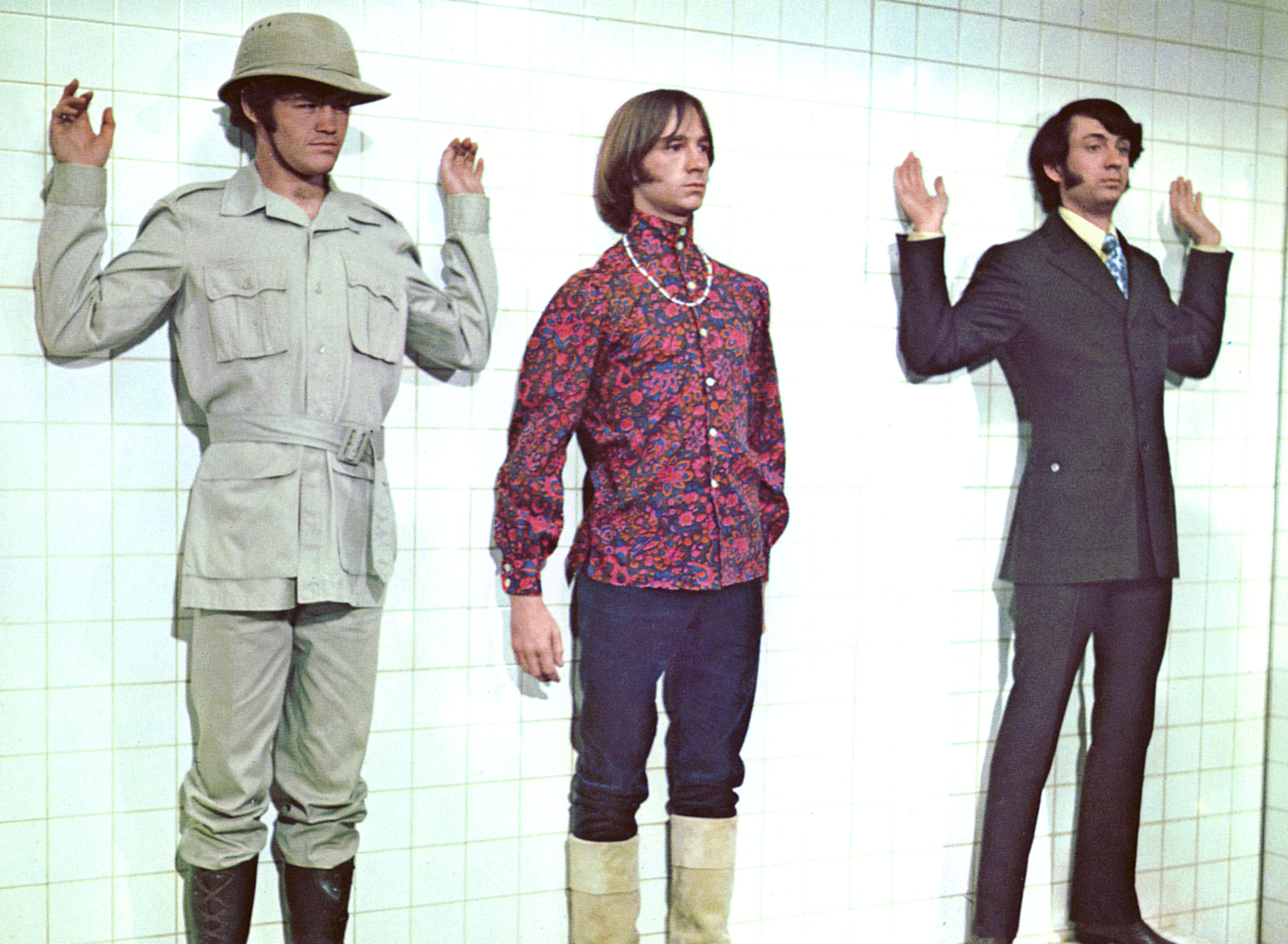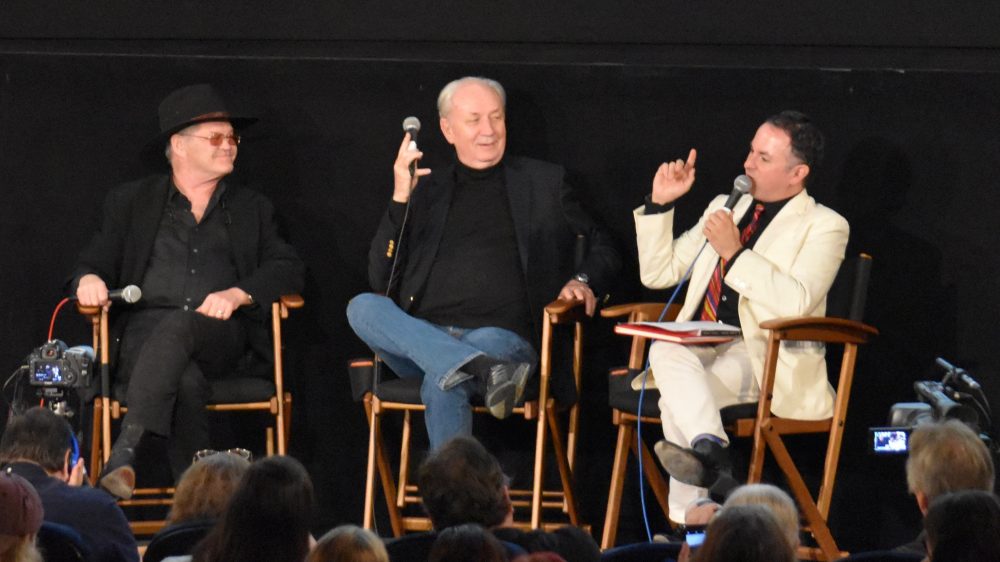A Pair of Monkees Puzzle Over Their Own ‘Head’ Trip at 50th Anniversary Screening
By Chris Morris
LOS ANGELES (Variety.com) – The rough, sometimes druggy genesis of the American independent movie business of the ‘60s and ‘70s was recalled by Micky Dolenz and Michael Nesmith of the Monkees during a sold-out 50th anniversary American Cinematheque screening of the band’s ill-fated feature film “Head.”
Looking out into the Egyptian Theatre before the film unspooled, Dolenz drolly asked one audience member, “You’ve seen it? Can you tell me what it’s about?”
The evening was hosted by the Monkees’ Boswell, producer Andrew Sandoval, who asked for a show of hands of how many in the crowd were returning “Head” cultists and how many were seeing it for the first time. The 60 percent or so making return trips were hugely enthusiastic, but Sandoval wasn’t making any promises to the 40 percent newbies, warning dryly, “We’ll see how many of you are here when we’re done.”
Relentlessly post-modern and lacking anything even vaguely resembling a conventional plotline, “Head” was the feature debut of director-writer Bob Rafelson, who co-wrote the film with then 31-year-old Jack Nicholson. Rafelson and creative partner Bert Schneider’s company Raybert had produced the hit NBC series “The Monkees,” which made stars of its fictitious, fabricated “rock band” — Dolenz, Nesmith, Peter Tork and David “Davy” Jones. (Ten years ago this month, Tork and Jones came to the same theater for a 40th anniversary screening, so now every member of has been to the Egyptian to defend — or just share bemusement about — the movie.)
Using every au courant film technique at their disposal, the production team created a determinedly non-linear film that played further tricks with the already self-referential, self-parodying roles familiar to viewers of the Monkees’ Beatles-inspired show. It made for head-spinning moviemaking — and it also utterly confused, perplexed and alienated the group’s young fans, and maybe even its stars.
Released months after the cancellation of “The Monkees” by NBC, “Head” brought the band’s two-year run as a hit-making machine to an abrupt halt. Moreover, the film itself was a colossal, virtually unseen flop that essentially ended the quartet’s career. However, like all things Monkees, it was ultimately embraced in later decades by the Pre-Fab Four’s cable-bred latter-day cult.
Viewed today, “Head” plays at dizzying and somewhat fatiguing speed. The film careens from one parody to another, spoofing Westerns, prize-fighting pictures, science fiction and, most notably, war movies (as the film was shot at the height of the Vietnam conflict). Its quick-cut visual bombardment employed color-blasting solarization, multiple exposures, jazzy optical printing, vault footage (from Rita Hayworth in “Gilda” to TV car salesman Ralph Williams) and a live concert sequence shot in Salt Lake City.
Though music seldom gets in the way of its antic shape-shifting, “Head” sports a couple of wonderful song sequences: a brightly solarized rendering of Gerry Goffin and Carole King’s “Porpoise Song,” shot underwater in the Bahamas, and Jones’ show-stopping song-and-dance reading of Harry Nilsson’s poignant “Daddy’s Song,” performed with the film’s choreographer Toni Basil.
Following the picture’s conclusion, Nesmith and Dolenz returned to the dais, with the latter quipping in mock relief, “I’m so glad none of you left — or at least not many.”
The musicians noted that the style of “Head,” and in fact the entire emerging creative scene in Hollywood during the late ‘60s, centered around youthful, hip talents — Nicholson, actor Harry Dean Stanton, artist Ed Ruscha — who were then just beginning to garner attention. Nicholson, previously best known for his work on Roger Corman’s exploitation films for American-International Pictures, was “the king of those guys,” Nesmith noted.
“Along came these young bucks,” Dolenz recalled, referring to such talents as Peter Fonda and Dennis Hopper (whose huge 1969 biker hit “Easy Rider” would be released through Raybert). This new generation of directors, writers and actors were intent on “breaking down the old traditional Hollywood paradigm.”
Both Rafelson and Schneider had family roots in Old Hollywood: The former was the nephew of Ernst Lubitsch’s screenwriter Samson Raphaelson, while the latter was the son of Abraham Schneider, who succeeded Harry Cohn as the head of Columbia Pictures. The younger Schneider took a radical route, winning a 1975 Academy Award as the producer of “Hearts and Minds,” Peter Davis’ Vietnam War documentary.
Nesmith noted that the use in “Head” of a notorious and shocking piece of Vietnam news footage — General Nguyen Ngoc Loan’s summary execution of a Viet Cong prisoner on a Saigon street in early ’68 — upset him so much that he couldn’t watch the rest of the film at an early screening. But Schneider was insistent on using the scene, telling the musician, “No, it’s anti-war, and it’ll have a big effect on the war.”
“Bert was very politically motivated and very left-wing,” Dolenz said, while Sandoval added bluntly, “Bert and Bob were both provocateurs.”
New ideas called for new techniques, both Nesmith and Dolenz noted. When the script for “Head” was being developed, the Monkees spent some time in Ojai, tossing ideas around with Nicholson and Rafelson. “We stayed pretty stacked up that whole weekend,” Nesmith recalled. “Rafelson said, ‘We’ll just riff.’ Nicholson was the king of riffing… He kept us all really high.”
“Jack came over to the house a number of times…[and] talked and smoked a bit,” Dolenz remembered. “He was getting insight into our personalities.”
Yet, in the end, despite significant creative input from the Monkees, Dolenz admitted, “I’m not sure what it’s all about… I don’t know exactly what Bob and Bert had in mind.”
From these group sessions emerged a movie with a unique structure: The first and last sequences in “Head” feature a leap off Long Beach’s Gerald Desmond Bridge.
“The movie does not have a beginning or an end — it’s circular,” Dolenz said. He recalled that at a New York party to launch the film that drew such art world luminaries as Andy Warhol, the feature ran simultaneously on five unsynchronized Moviolas, allowing attendees to drop into the “story” wherever they liked.
Ultimately, moviegoers decided to drop out on “Head” completely. Poorly reviewed when it was reviewed at all, the feature swiftly disappeared off American screens. Its abject failure and the cancellation of “The Monkees” hastened the departure of Peter Tork from the group in early 1969; the remaining members called it quits in 1970. Many reunions would follow from the ‘90s on; Nesmith and Dolenz noted their plans for more duo concert dates in 2019. (A Monkees Christmas album featuring Dolenz, Nesmith and Tork was also released last month.)
While Schneider (who died in 2011) and Rafelson went on to make such commercial and artistic successes as “Five Easy Pieces” and “The King of Marvin Gardens,” the cataclysmic flop of “Head” robbed the producers of an outrageous bit of advertising copy.
Dolenz recalled that when he asked Rafelson about the cryptic title of the movie, the director replied, “When we make our next movie, we’re gonna be able to say: From the Producers Who Gave You ‘Head.’”


